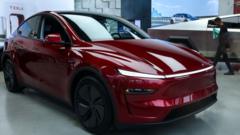With Tesla's anticipated entry into India, the electric vehicle sector faces questions about affordability and local adaptation challenges. Competing against established brands like Tata Motors, Tesla's $40,000 base model positions it as a luxury option. While India's EV market expands due to favorable policies, hurdles such as market size, road conditions, and lower import duties for local manufacturing may impact Tesla’s strategy.
Will Tesla Navigate India's Price-Sensitive EV Market?

Will Tesla Navigate India's Price-Sensitive EV Market?
As Tesla prepares to enter the Indian market, challenges abound from local competition, pricing, and the need for infrastructure adaptations.
Tesla has made strides toward entering India’s burgeoning electric vehicle (EV) market, which has seen explosive growth. The California-based automotive pioneer has recently started hiring for several positions in Delhi and Mumbai, signaling its intention to establish a presence amid growing competition.
India, the third-largest economy in Asia, offers a promising opportunity for Tesla, especially as global EV sales experience declines and competition from Chinese manufacturers intensifies. However, a critical question raises its head: can Tesla truly penetrate India’s price-sensitive market?
Currently, Tata Motors leads the Indian EV sector with a commanding 60% market share, followed by MG Motors and Mahindra and Mahindra. These domestic manufacturers offer EVs that are considerably more affordable than Tesla's, with the latter's base model priced around $40,000 (£31,637). This perception positions Tesla as a luxury brand competing not only with local players but also higher-end offerings from automakers like Hyundai, BMW, and Mercedes.
Simply put, without a more cost-effective model tailored for Indian consumers, Tesla could find itself relegated to a niche market. Moreover, adapting Tesla vehicles to accommodate India's diverse road conditions poses another challenge. Tesla's low ground clearance would likely necessitate modifications, potentially rising manufacturing costs and raising questions about the feasibility of pursuing substantial engineering changes for a comparatively small market segment.
Hormazd Sorabjee, the editor of Autocar India, emphasizes the challenges that even high-end global manufacturers have faced in adapting vehicles for the Indian market under similar conditions. EVs represent less than 3% of total passenger vehicle sales in India, underscoring the market's nascent stage. While infrastructure, including charging stations, is incrementally improving, only about 25,000 exist nationwide.
Nonetheless, India is actively courting Tesla through ambitious policy frameworks aimed at transitioning to electric mobility. The nation's goal is to electrify 30% of private cars, 70% of commercial vehicles, and significant percentages of two and three-wheelers by 2030. Government subsidies for EVs are among the most generous in the world, covering up to 46% of the price for top-selling models.
Since cutting import duties on EVs in 2022 for global automakers willing to commit to Indian production, Tesla now faces a considerably lower duty of 15% for its vehicles under specific conditions. This policy aims to encourage foreign manufacturers to establish localized production, which could disrupt the current playing field favorably towards Tesla, though it raises concerns among domestic producers about competitive equity.
Companies like Mahindra and Mahindra view Tesla's entry positively, believing it will strengthen India's EV ecosystem. They focus on introducing innovative technologies to address critical issues, including "range anxiety." However, Tesla's reputation and technological advancements give it an edge that may challenge local players.
As the market shifts towards premium vehicles, especially among younger Indian consumers, Tesla's allure may grow. Yet despite favorable government policies and a rising demand for luxury EVs, Tesla has yet to commit to building manufacturing facilities in India, indicating it will initially export vehicles instead.
The timeline for local production hinges on factors such as the increasing affluence of Indian consumers and how tariff negotiations with the U.S. unfold. With debates on manufacturing in foreign markets still echoing in the background, Tesla’s initial foray may primarily involve swanky showrooms catering to the wealthy, rather than generating broader job opportunities in India’s economy.
















